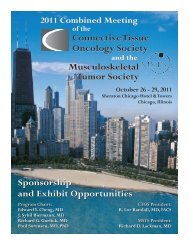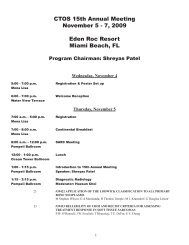207 Poster Session 2 - Connective Tissue Oncology Society
207 Poster Session 2 - Connective Tissue Oncology Society
207 Poster Session 2 - Connective Tissue Oncology Society
You also want an ePaper? Increase the reach of your titles
YUMPU automatically turns print PDFs into web optimized ePapers that Google loves.
Scientific <strong>Poster</strong>s – <strong>Poster</strong> <strong>Session</strong> 2pre-operatively. A pre-operative diagnosis of fibroids wasmade in 28%. The majority of patients had undergone appropriatepre-operative investigations (96%) and surgery(72%); lymph node dissection was performed in 14%.Eight patients were upstaged with metastatic disease afterradical surgery. Commonly, patients were referred to seekguidance on the role of adjuvant or palliative therapy. Fiftypatients were discussed with regards to the managementof metastatic disease and offered: metastatectomy 10%;systemic therapy 25% (54% enrolled into a clinical trial) andendocrine therapy (10%). Median loco-regional disease-freesurvival (DFS) was 29.6 months, median distant DFS-13.4months and overall survival at 1 yr- 81%.Conclusion: This audit has highlighted an unmet needin the management of G-STS. Clear guidelines need to becommunicated to gynae-oncology MDTs. The followingrecommendations may address referral pathway inconsistency:(1) a full dataset be provided upon referral to helpdetermine primary management and adjuvant therapies(2) an increased awareness of radiological characteristicsof G-STSs to facilitate early referral and appropriate surgicalmanagement, (3) histological review by a designatedsarcoma pathologist, particularly endocrine status in LMSand ESS and (4) early referral for the management of metastaticdisease. Clinical trials in the adjuvant and metastaticsetting are in progress to provide further clarification oftreatments in this challenging disease.Methods: This is an interim analysis of a 12-month studyof the symptom burden of GIST. Persons with GIST, beingfollowed at MD Anderson Cancer Center, gave IRB-approvedinformed consent and then rated their symptomson the provisional MD Anderson Symptom Inventory forGIST (MDASI-GIST) every 1-2 weeks. The MDASI-GISTis a questionnaire that asks patients to rate the worst severityof 22 symptoms and amount of interference with6 types of daily activities in the last 24 hours on a 0 (nosymptom or interference) to 10 (as bad as can be imaginedor complete interference) scale. The symptom burden ofGIST will be described through descriptive and mixedmodeling analyses.Results: As of April 30, 2012, 64 subjects had been on studyfor at least 3 months. Demographic and treatment informationat study entry for subjects is in Table 1. Figure 1 isa graph of the mean symptom and interference severityover 12 weeks. The means and standard deviations (SD)of the 5 most severe symptoms and the interference itemsare in Table 2.Mixed modeling analysis demonstrated thatpatients on imatinib therapy had significantly lower severityof the 5 most severe symptoms than patients receivingother treatments estimate = -1.00, p-value = 0.021).Conclusion: Symptom burden experienced by patientswith GIST receiving treatment are mild and stable overseveral months. The most severe symptoms are mainlyfatigue-related. The results of this preliminary analysiswarrant further investigation of the symptom burden ofGIST, including long term symptom burden, changes insymptom burden associated with changes in disease status,identification of patient groups who may experince moresevere symptom burden, and the influence of symptomburden on treatment adherence. Data collection for thisstudy is ongoing.<strong>Poster</strong> #122SYMPTOM BURDEN OF GASTROINTESTINALSTROMAL TUMORS (GIST) OVER 3 MONTHSLoretta A. Williams, PhD 1 ; Dejka M. Araujo 2 ; Nazim N. Ali 1 ;Mary L. Sailors 1 ; Kaiyan Jing 1 ; Jonathan C. Trent 3 ;Charles S. Cleeland 11Symptom Research, The University of Texas MD AndersonCancer Center, Houston, TX, USA; 2 Sarcoma Medical<strong>Oncology</strong>, The University of Texas MD Anderson CancerCenter, Houston, TX, USA; 3 Sylvester Comprehensive CancerCenter, University of Miami, Miami, FL, USAObjective: Symptom burden is the combined impact ofdisease- and therapy-related symptoms on patient functionalability. The objective of this study is to describe thesymptom burden experienced by patients receiving treatmentfor GIST over a 3 month period.Figure 1. Symptom Severity and Interference MeansOver 12 Weeks224






